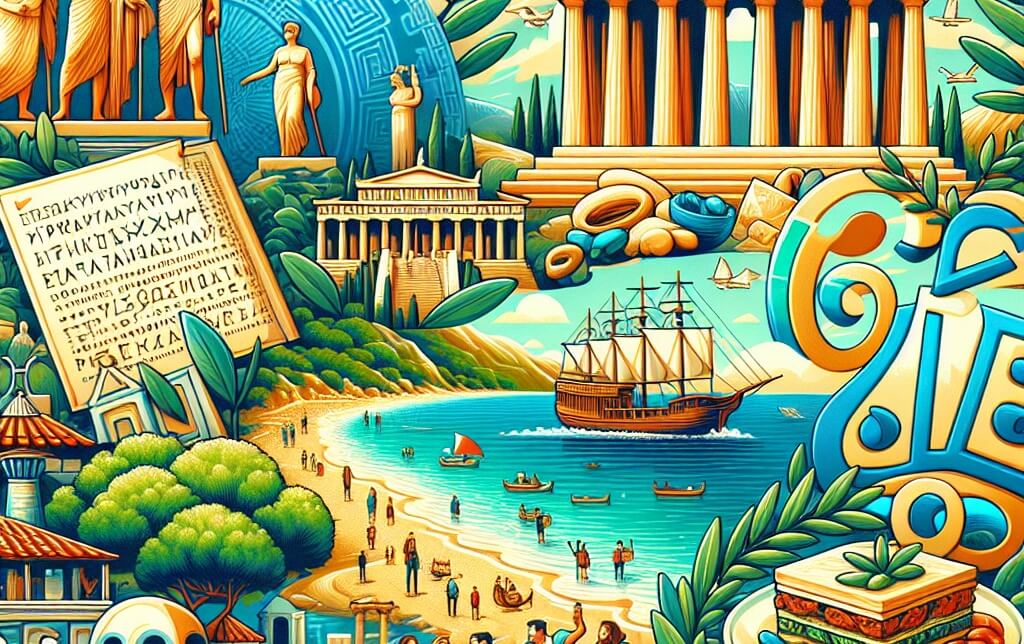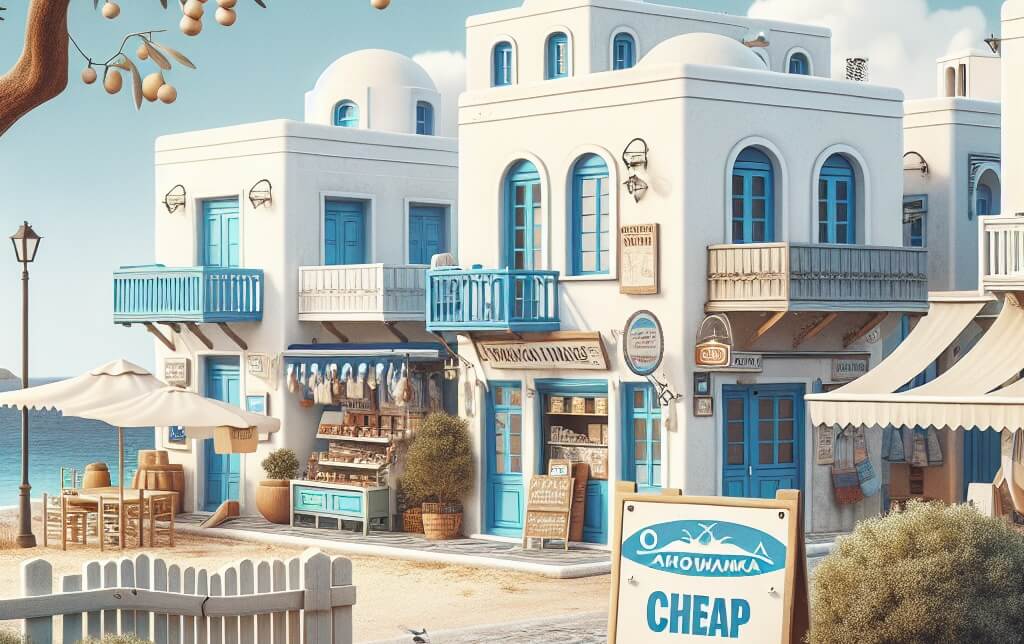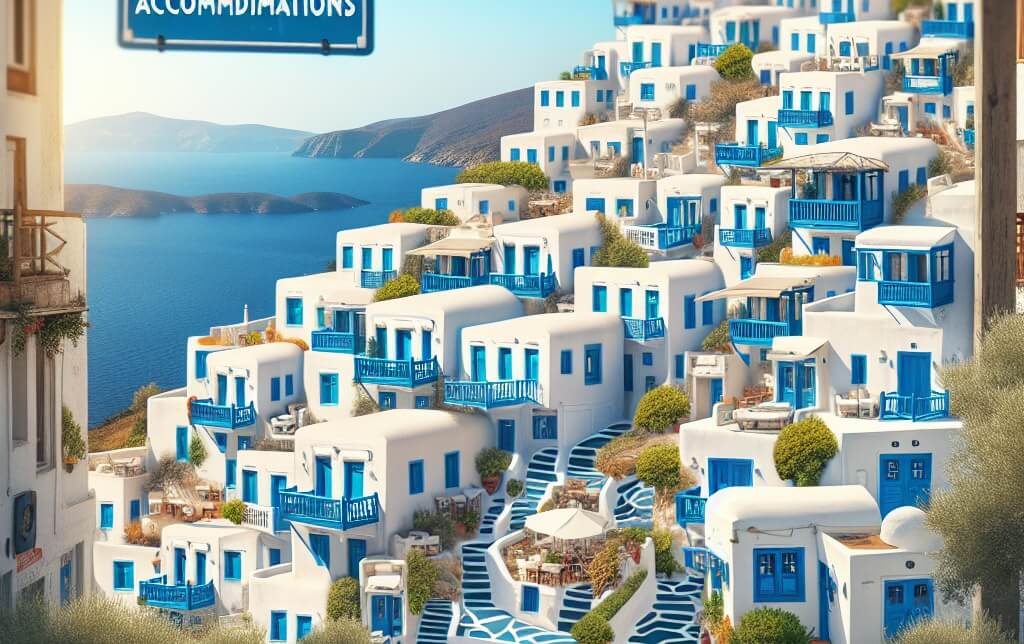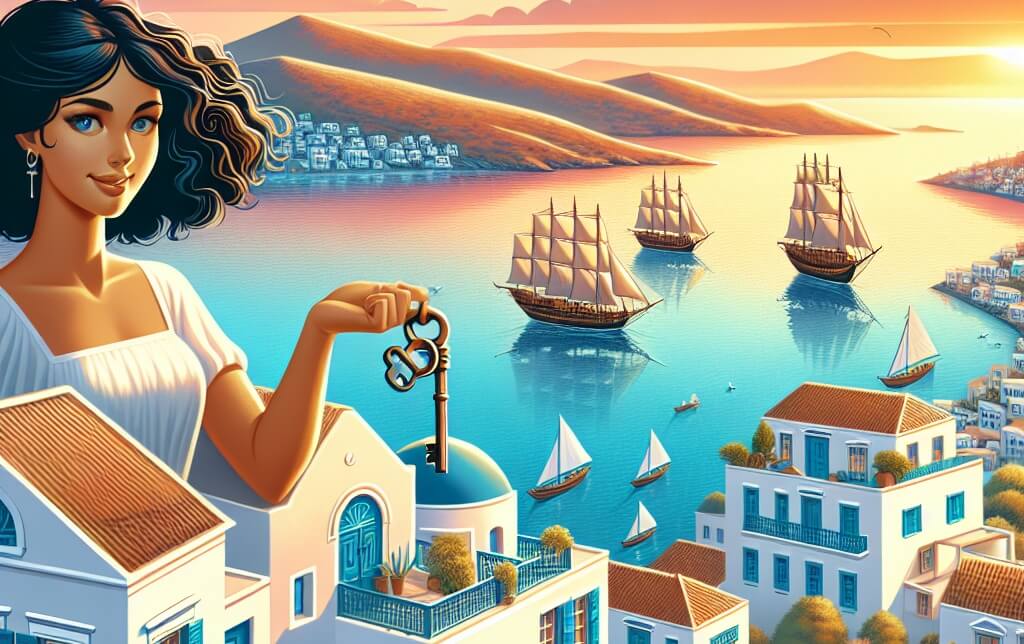
Explore Kato Achaia Greece: Stunning Coastal Destination
Kato Achaia, located in Greece, is a captivating coastal destination that promises a truly stunning experience for travelers seeking natural beauty and tranquility. Nestled along the crystal-clear waters of the Ionian Sea, this picturesque region boasts sandy beaches, rugged cliffs, and lush greenery, making it a paradise for nature enthusiasts and beachgoers alike. Visitors to Kato Achaia can indulge in a variety of outdoor activities, from swimming and sunbathing to hiking along scenic coastal trails. The charming local villages offer a glimpse into traditional Greek culture, with quaint tavernas serving delicious Mediterranean cuisine and friendly locals eager to share their stories. With its breathtaking scenery and warm hospitality, Kato Achaia is a must-visit destination for those looking to immerse themselves in the beauty of the Greek coast.
Introduction
The region of Kato Achaia in Greece is a place of rich historical significance and natural beauty. Its name translates to "Lower Achaia," reflecting its location in the southern part of the Achaia region. The area is known for its picturesque landscapes, including lush vineyards, olive groves, and stunning coastal views. Visitors to Kato Achaia can immerse themselves in the region's ancient history, with archaeological sites such as the Temple of Zeus in Olympia nearby. Additionally, the warm hospitality of the locals and the delicious cuisine of the region make Kato Achaia a truly inviting destination for travelers seeking a blend of culture and relaxation.
Provide a brief overview of Kato Achaia, Greece, including its location, population, and significance.
Kato Achaia is a municipality located in the western part of the Peloponnese peninsula in Greece. Situated in the region of Achaea, Kato Achaia is bordered by the Gulf of Patras to the north and the municipalities of Aigialeia and West Achaea to the east. The population of Kato Achaia is estimated to be around 15,000 residents, with the main town being Kato Achaia itself. The municipality is known for its agricultural activities, particularly the cultivation of citrus fruits and olives. Additionally, Kato Achaia is home to several historical sites, including the Byzantine castle of Chlemoutsi, which adds to its cultural significance in the region.
Geography and Climate
Kato Achaia, Greece, is characterized by a diverse geography and climate that significantly shape the region. Located in the western part of the country, Kato Achaia boasts a varied landscape that includes coastal areas, plains, and mountains. The coastal areas offer a temperate Mediterranean climate with mild, wet winters and hot, dry summers, ideal for agriculture and tourism. In contrast, the mountainous regions experience cooler temperatures and more precipitation, supporting lush forests and providing a habitat for diverse flora and fauna. The combination of these geographical features contributes to the overall richness and biodiversity of Kato Achaia, making it a unique and captivating destination for visitors and residents alike.
Describe the geographical features of Kato Achaia, such as its location in the Peloponnese region and its proximity to the Ionian Sea. Discuss the climate of the area, including average temperatures, rainfall, and any unique weather patterns.
Kato Achaia, located in the Peloponnese region of Greece, is situated near the Ionian Sea, providing it with a picturesque coastal setting. The region boasts a diverse landscape characterized by lush greenery, rolling hills, and fertile plains. The proximity to the Ionian Sea influences the climate of Kato Achaia, resulting in mild winters and warm summers. The average temperature ranges from 10°C in the winter months to 30°C in the summer, making it an ideal destination for those seeking a temperate climate. The area receives a moderate amount of rainfall throughout the year, with the wettest months typically occurring in winter. Additionally, Kato Achaia experiences occasional thunderstorms during the summer months, adding a unique weather pattern to the region's climate.
History
The history of Kato Achaia, Greece is deeply rooted in the ancient civilizations that once thrived in the region. From the time of the Mycenaeans to the Roman Empire and beyond, this area has been a significant center of commerce, culture, and political power. The archaeological sites scattered throughout Kato Achaia bear witness to the rich history of the area, with artifacts and ruins providing a glimpse into the daily lives of its past inhabitants. The strategic location of Kato Achaia along major trade routes has played a crucial role in shaping its historical development, as evidenced by the diverse influences that have left their mark on the region. Through the centuries, Kato Achaia has experienced periods of prosperity, conquest, and cultural exchange, all of which have contributed to its unique historical identity.
Explore the historical background of Kato Achaia, highlighting significant events, ancient civilizations, and notable landmarks. Discuss the influence of different cultures and empires on the region.
Kato Achaia, located in Greece, possesses a rich historical background shaped by various civilizations and empires. The region was inhabited by ancient Greek tribes and later became part of the Roman Empire, contributing to its cultural and architectural heritage. Notable landmarks in Kato Achaia include the ancient city of Patras, known for its Roman amphitheater and medieval castle, and the archaeological site of Rhion, showcasing remnants of ancient settlements. The Byzantine Empire also left its mark on the region through the construction of churches and fortifications. Additionally, the Ottoman rule in Kato Achaia influenced the local culture and architecture, evident in the design of mosques and public buildings. Overall, the diverse influences of different cultures and empires have played a significant role in shaping the historical identity of Kato Achaia.
Archaeological Sites
Archaeological sites in Kato Achaia, Greece, hold significant historical and cultural importance. These sites provide invaluable insights into the ancient civilizations that once thrived in the region, offering a glimpse into the daily lives, beliefs, and practices of past societies. The preservation and study of these archaeological sites are crucial for understanding the evolution of human civilization and for appreciating the rich heritage of the area. Furthermore, these sites serve as a platform for ongoing research and exploration, shedding light on the complex interactions between different cultures and civilizations throughout history. Overall, the archaeological sites in Kato Achaia, Greece, stand as a testament to the enduring legacy of the region and the importance of safeguarding our shared cultural heritage.
Highlight the archaeological sites in Kato Achaia, including any ancient ruins, temples, or historical structures. Discuss their significance and the ongoing research and preservation efforts.
Kato Achaia, located in Greece, boasts a rich archaeological heritage with several notable sites that hold historical and cultural significance. Among the prominent sites are the ancient ruins of the Temple of Zeus in Olympia, a temple dedicated to the king of the gods in Greek mythology. This site is of great importance as it hosted the ancient Olympic Games, showcasing the athletic prowess of the ancient Greeks. Additionally, the Temple of Apollo Epicurius, situated in Bassae, is another remarkable archaeological site in Kato Achaia. This temple is renowned for its unique architecture and is considered one of the best-preserved ancient Greek temples. Ongoing research and preservation efforts in Kato Achaia focus on protecting these significant sites from natural elements and human intervention. Archaeologists and conservationists work diligently to uncover more about the history and culture of the region while ensuring the preservation and maintenance of these invaluable structures for future generations.
Tourism and Attractions
Kato Achaia, Greece, offers a diverse range of tourism and attractions that cater to a wide variety of interests. From its beautiful beaches along the Ionian Sea to its historical sites such as the ancient city of Patras, there is something for everyone to enjoy in this region. The local cuisine, known for its fresh seafood and Mediterranean flavors, is a highlight for many visitors. Additionally, the area boasts a vibrant cultural scene with festivals, art galleries, and traditional music performances that showcase the rich heritage of the region. Overall, Kato Achaia provides a compelling destination for tourists seeking a blend of natural beauty, history, and cultural experiences.
Discuss the tourism industry in Kato Achaia, including popular attractions, beaches, and natural landmarks. Mention any cultural festivals or events that draw visitors to the area.
Kato Achaia, located in Greece, boasts a thriving tourism industry with a diverse range of attractions that draw visitors from far and wide. The region is renowned for its stunning beaches, such as Kalogria Beach and Lakopetra Beach, which offer crystal-clear waters and sandy shores perfect for relaxation and water activities. Natural landmarks like the picturesque Kotychi Lagoon and the lush Strofylia Forest provide opportunities for hiking and bird-watching, appealing to nature enthusiasts. Cultural festivals like the annual Cherry Festival in Aegio and the Carnival celebrations in Patras attract visitors seeking to immerse themselves in the local traditions and vibrant atmosphere of the region. Overall, Kato Achaia offers a rich tapestry of experiences that cater to the varied interests of tourists, making it a sought-after destination in Greece.
Local Economy
The local economy in Kato Achaia, Greece, plays a vital role in sustaining the community's livelihood and overall well-being. As a small town situated in the Achaia region, the economy of Kato Achaia is primarily driven by agriculture, tourism, and small businesses. The fertile land in the area allows for the cultivation of various crops such as olives, citrus fruits, and vegetables, which not only provide sustenance for the local population but also contribute to the region's export industry. Additionally, the town's proximity to the coast attracts tourists seeking a tranquil seaside getaway, further boosting the economy through the hospitality and service sectors. Small businesses, including shops, restaurants, and artisanal producers, also play a significant role in the local economy by providing employment opportunities and fostering a sense of community pride. Overall, the diverse economic activities in Kato Achaia contribute to its resilience and sustainability, making it a thriving hub within the Achaia region.
Examine the main industries and economic activities in Kato Achaia, such as agriculture, fishing, tourism, or manufacturing. Discuss any challenges or opportunities for economic growth in the region.
Kato Achaia, a region in Greece, boasts a diverse economic landscape with agriculture, fishing, tourism, and manufacturing being the main industries driving its economy. Agriculture plays a significant role in the region, with the cultivation of olives, citrus fruits, and vegetables being prominent. The fishing industry also thrives due to the region's proximity to the Ionian Sea. Tourism is another vital sector, with the area's beautiful beaches and historical sites attracting visitors throughout the year. Additionally, manufacturing activities, particularly in food processing and textile production, contribute to the economic vitality of Kato Achaia. Despite these strengths, the region faces challenges such as limited infrastructure, seasonal fluctuations in tourism, and competition from other regions. However, there are opportunities for economic growth, including investing in sustainable agriculture practices, promoting eco-tourism, and enhancing transportation networks to attract more businesses and visitors. By addressing these challenges and capitalizing on its strengths, Kato Achaia can further stimulate economic development and prosperity in the region.
Social and Cultural Aspects
In the context of Kato Achaia, Greece, the social and cultural aspects play a significant role in shaping the daily life and identity of the community. The region's rich history and traditions are reflected in various social practices, such as communal gatherings and celebrations that bring people together to honor their heritage. Additionally, cultural events, such as music and dance performances, serve as a means of preserving and promoting the local customs and values. Furthermore, the strong sense of community and interconnectedness among residents fosters a supportive and inclusive environment, where individuals can find belonging and solidarity. Overall, the social and cultural aspects of Kato Achaia contribute to the cohesion and vibrancy of the community, serving as a foundation for its collective identity and sense of pride.
Explore the social and cultural aspects of Kato Achaia, including traditions, customs, and local cuisine. Discuss the impact of globalization and modernization on the community.
Kato Achaia, located in Greece, boasts a rich tapestry of social and cultural aspects that reflect its unique identity. The community is deeply rooted in traditions and customs that have been passed down through generations, shaping the way of life for its residents. Traditional festivals and celebrations play a significant role in the social fabric of Kato Achaia, bringing the community together to honor their heritage and values. Local cuisine is a cornerstone of the culture, with dishes like moussaka, souvlaki, and baklava showcasing the region's culinary expertise. However, the impact of globalization and modernization is increasingly evident in Kato Achaia, as the community grapples with the challenges of balancing tradition with the pressures of a rapidly changing world. While advancements in technology and communication have brought new opportunities, they have also introduced changes that challenge the preservation of local customs and practices. As Kato Achaia navigates these complexities, it strives to maintain its cultural heritage while embracing the benefits of a more interconnected global society.
Education and Research
In Kato Achaia, Greece, the intersection of education and research plays a crucial role in fostering intellectual growth and societal advancement. The pursuit of knowledge through education provides individuals with the necessary skills and expertise to contribute meaningfully to their communities. Meanwhile, research serves as the driving force behind innovation and progress, leading to the development of new technologies, solutions, and ideas that address the challenges of our time. By investing in education and research, Kato Achaia not only enhances its human capital but also strengthens its position as a hub of intellectual excellence and innovation in the region.
Discuss the educational institutions in Kato Achaia, including schools, colleges, or research centers. Highlight any notable research or academic achievements related to the region.
Kato Achaia, located in Greece, boasts a range of educational institutions that contribute significantly to the academic landscape of the region. Among the notable schools in Kato Achaia are the local primary and secondary schools that provide foundational education to the community's youth. Additionally, the region is home to colleges and vocational training centers that offer specialized education in various fields. Notable research centers in Kato Achaia focus on areas such as agriculture, environmental science, and cultural heritage preservation. One noteworthy academic achievement in the region includes groundbreaking research on sustainable agriculture practices that have garnered international recognition. The educational institutions in Kato Achaia play a vital role in fostering knowledge and innovation within the community and beyond.
Environmental Concerns
In the region of Kato Achaia, Greece, environmental concerns are of paramount importance due to the area's rich natural beauty and ecological significance. The preservation of the local flora and fauna, as well as the protection of the surrounding landscapes, is crucial to maintaining the overall health and sustainability of the region. Efforts to mitigate pollution, conserve water resources, and promote sustainable practices are essential in safeguarding the environment for future generations. It is imperative for stakeholders in Kato Achaia to prioritize environmental conservation and work collaboratively towards a greener and more sustainable future for the region.
Address any environmental issues or concerns specific to Kato Achaia, such as pollution, deforestation, or conservation efforts. Discuss the importance of preserving the natural resources of the area.
Kato Achaia, located in Greece, faces a range of environmental issues that require urgent attention to ensure the preservation of its natural resources. Pollution, particularly from industrial activities and agricultural runoff, poses a significant threat to the region's air and water quality. Deforestation, driven by urbanization and unsustainable land use practices, diminishes the biodiversity and ecological balance of the area. Conservation efforts are essential to safeguard the unique ecosystems and habitats that exist in Kato Achaia. Preserving the natural resources of this region is crucial not only for the well-being of its inhabitants but also for the overall health of the planet. By protecting the environment in Kato Achaia, we can ensure a sustainable future for generations to come and maintain the beauty and richness of this unique landscape.
Integration of Pertinent Topics
The integration of pertinent topics in the context of Kato Achaia, Greece, involves a comprehensive understanding and incorporation of relevant subject matters that directly impact the region. This process entails identifying key issues such as cultural heritage preservation, environmental sustainability, economic development, and community engagement within the specific context of Kato Achaia. By integrating these pertinent topics, stakeholders can work collaboratively to address challenges, leverage opportunities, and create a more holistic and sustainable approach to decision-making and planning in the region. This integrated approach ensures that all aspects of the community are considered and prioritized, leading to more effective and inclusive development strategies for Kato Achaia, Greece.
Integrate the following topics extracted from top Google results that are directly pertinent to Kato Achaia, Greece:
Kato Achaia, a municipality in Greece located in the western part of the country, is known for its rich history, picturesque landscapes, and cultural heritage. The region is home to several notable attractions, including the Kato Achaia Beach, which offers stunning views of the Ionian Sea and is a popular destination for tourists seeking relaxation and natural beauty. Additionally, the area boasts a variety of traditional Greek tavernas and restaurants, where visitors can sample authentic Greek cuisine and experience the local flavors. Kato Achaia is also renowned for its historical sites, such as the medieval castle of Chlemoutsi, a well-preserved fortress that dates back to the Byzantine era. Overall, Kato Achaia offers a unique blend of natural beauty, cultural significance, and historical charm, making it a must-visit destination for travelers interested in exploring the beauty of Greece.
Local government and administration
Local government and administration in Kato Achaia, Greece, play a crucial role in the effective functioning of the region. The local government is responsible for overseeing various aspects of daily life, including public services, infrastructure development, and community welfare. The administration works diligently to ensure that the needs and concerns of the residents are addressed promptly and efficiently. Through strategic planning and resource allocation, the local government in Kato Achaia strives to enhance the quality of life for its citizens and promote sustainable growth. By fostering collaboration between different agencies and stakeholders, the administration works towards achieving common goals and objectives that benefit the entire community.
Transportation and infrastructure
Transportation and infrastructure play a crucial role in the development and connectivity of Kato Achaia, Greece. The efficient functioning of transportation systems, including roads, bridges, and public transport, is essential for facilitating the movement of people and goods within the region. Investing in infrastructure projects not only enhances the overall quality of life for residents but also attracts businesses and promotes economic growth. By prioritizing the maintenance and improvement of transportation networks in Kato Achaia, the local government can ensure the sustainable development and prosperity of the region for years to come.
Local cuisine and gastronomy
In the region of Kato Achaia, Greece, the local cuisine and gastronomy are deeply rooted in tradition and reflect the rich cultural heritage of the area. The cuisine of Kato Achaia is characterized by its use of fresh, locally sourced ingredients such as olive oil, herbs, and vegetables grown in the fertile soil of the region. Traditional dishes like moussaka, stuffed grape leaves, and fresh seafood are staples of the local gastronomy, showcasing the flavors and culinary techniques passed down through generations. The emphasis on simple, yet flavorful dishes highlights the importance of quality ingredients and the art of slow cooking. Overall, the local cuisine of Kato Achaia embodies a true taste of Greece, inviting visitors to experience the authentic flavors of the region.
Traditional crafts and industries
In Kato Achaia, Greece, traditional crafts and industries play a significant role in preserving the cultural heritage and economic vitality of the region. The artisanal skills passed down through generations contribute to the unique identity of the community and serve as a source of pride for its residents. Industries such as pottery, weaving, and olive oil production not only provide employment opportunities but also attract tourists seeking authentic experiences. By supporting and promoting these traditional crafts, Kato Achaia maintains a connection to its past while also fostering sustainable development for the future.
Local festivals and celebrations
Local festivals and celebrations play a significant role in the cultural fabric of Kato Achaia, Greece. These events not only serve as opportunities for the community to come together in joyous celebration but also act as a means of preserving and passing on traditional customs and practices from one generation to the next. The rich tapestry of local festivals in Kato Achaia reflects the deep-rooted history and heritage of the region, showcasing a diverse range of music, dance, food, and rituals that are unique to this area. From religious festivals honoring saints to seasonal celebrations marking the harvest or the changing of the seasons, these events serve as a vibrant expression of the cultural identity and spirit of the people of Kato Achaia.
Conclusion
In conclusion, the region of Kato Achaia in Greece offers a rich cultural and historical experience for visitors. With its picturesque landscapes, ancient ruins, and charming villages, Kato Achaia provides a unique glimpse into the country's past and present. From exploring the archaeological sites to savoring the local cuisine, there is no shortage of activities to enjoy in this enchanting region. Whether you are a history enthusiast, a nature lover, or simply seeking a peaceful getaway, Kato Achaia has something to offer for everyone. Plan your visit to this hidden gem in Greece and immerse yourself in its beauty and heritage.
Summarize the key points discussed in the outline and emphasize the unique aspects and significance of Kato Achaia, Greece. Conclude with any future prospects or challenges the region may face.
The outline presented delves into the unique aspects and significance of Kato Achaia, Greece. Kato Achaia is a region renowned for its rich history, picturesque landscapes, and vibrant cultural heritage. The outline highlights the region's strategic location near the Gulf of Patras and its historical importance as a hub for trade and commerce. Moreover, Kato Achaia's archaeological sites, such as the Ancient Olympia, serve as a testament to its historical significance. The region's natural beauty, including its stunning beaches and lush countryside, further contribute to its appeal. However, Kato Achaia also faces challenges, such as sustainable development and preserving its cultural heritage amidst modernization. Moving forward, the region must carefully balance growth and preservation to ensure a sustainable future for generations to come.









